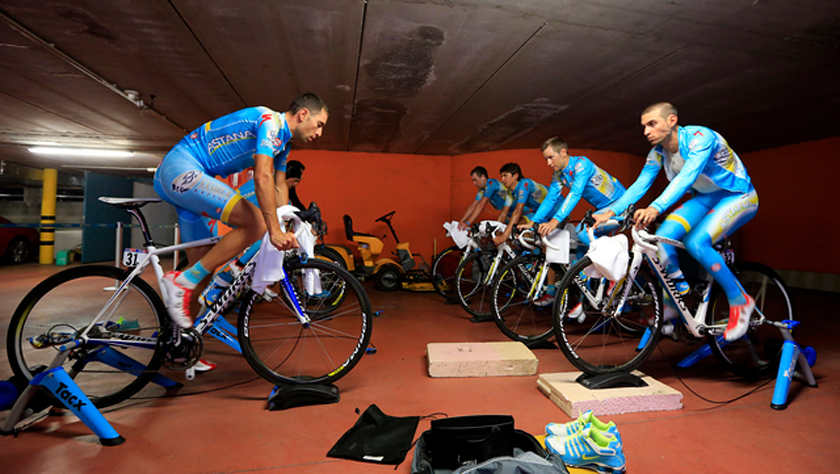Many cyclists hate the turbo, but when used correctly it is a fantastic training tool.
In my opinion, riding the turbo is more enjoyable than riding in the rain and you probably won't have to suffer traffic lights, fumes or punctures. Here's my tips on how to make turbo training enjoyable.
In my opinion, riding the turbo is more enjoyable than riding in the rain and you probably won't have to suffer traffic lights, fumes or punctures. Here's my tips on how to make turbo training enjoyable.
Turbo training versus road training
There is a difference in pedalling action between a turbo and riding on the road. This is due to the nature of the resistance unit, and the cyclist's inertia and varying effect of hills and wind.
On a turbo, the resistance tends to be fairly constant throughout the pedal stroke, so more muscles are recruited to pull the leg on the upstroke. This mimics climbing more than riding on the flat.
Turbo manufacturers try to get around this issue by designing units that mimic the feel of the road.
Large flywheels give more inertia, so make the pedal stroke feel more road-like. For example Kurt Kinetic make a bolt-on flywheel (Kurt Kinetic Pro Flywheel) which increases the mass to 18lb/8kg. Although the effort to maintain a speed is the same, it takes less thought to maintain it.
Fan units give a progressive resistance that feels similar to road riding, although they are noisy. A well regarded choice is the Lemond Revolution Trainer
Magnetic resistance units work well as they don't vary too much with temperature and are relatively quiet.
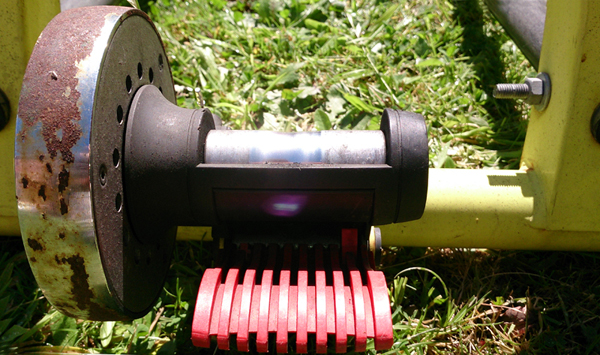
This is the roller of my well loved Tacx Swing turbo trainer. I spent about 4 hours a week on this for 3 years. It has rusted as I leave it outside in the rain, but the bearings still run fine. Its only problem was that the resistance adjustment cable corroded through, but it isn't needed anyway. Just set a low resistance and use the gears as needed. The current model is the Tacx Blue Motion.
Fluid units tend to vary with temperature as the viscosity of the fluid varies. They do tend to be as quiet as magnetic trainers.
Rollers are another form of stationary trainer. Some people love them as it takes away some of the boredom of turbo training. I prefer to not have to worry about coordination and steering and just get on with the work and get myself into the zone.
You can get resistance units for rollers, but I think they are best used for warm ups before races (no need to change skewers or wheels, no need to risk punctures riding around a town center before a crit).
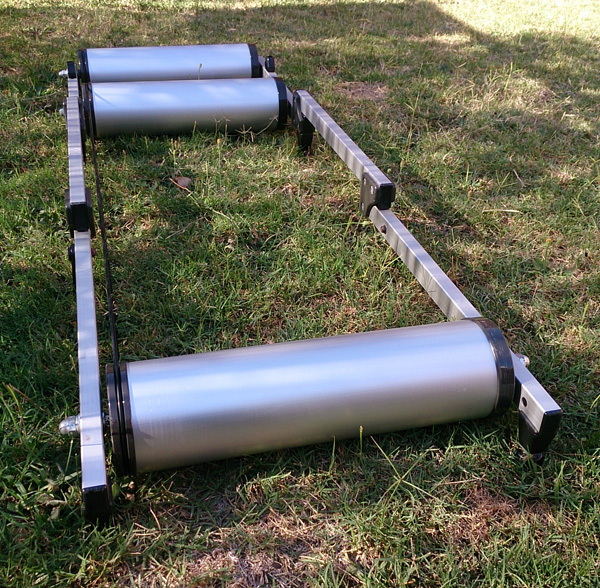
The Minoura Action Roller Advance . Aluminium drums, good bearings, so not noisy. It is possible to attach a resistance unit to the rear roller.
Nice one for sale
here.
. Aluminium drums, good bearings, so not noisy. It is possible to attach a resistance unit to the rear roller.
Nice one for sale
here.
A friend told me you could put a towel under a roller to add resistance. Unfortunately he had plastic rollers. The roller melted and drooped which made his rollers feel like cobbles.
A friend told me you could put a towel under a roller to add resistance. Unfortunately he had plastic rollers. The roller melted and drooped which made his rollers feel like cobbles.
The SRM Indoortrainer is the next step up on trainers. Costing about $5000 without cranks (add an extra $2500), this unit is solid, adjustable, and comes with a 65lb/30kg flywheel which can spin at a speed that is not proportional to your gearing, thus best mimicking road feel.
The SRM Indoor Trainer
Finally I have seen a treadmill for bikes such as the Tacx Klimtrainer, costing about USD $15,000.
See it here at 02:05 YouTube of Tacx Klimtrainer.
That would be awesome if you had the space.
Use low resistance and high gearing
Trainers give a better feel if you set a low resistance and use high gears. The pedal action won't feel as heavy for the same power output as the flywheel is spinning faster. I recommend a dedicated turbo wheel with a close ratio block on it, e.g. 12-23. Set the resistance so the highest power you need to generate correlates to 53x12 e.g. 600W at 100rpm. After that, leave the turbo resistance alone and use gear changes to alter the difficulty.
If you want to ride at very specific power levels, then the turbo is great. There won't be hold ups due to traffic or lights. Constant power is easier to maintain as there are no descents or gear changes needed. Cadence and power can be carefully monitored as you are not needing to look where you are going.
If the weather is icy, then turbo may be your only option. Turbo is also safer at night.
Many pros prefer to ride on the road where possible, as this most closely resembles racing, but they don't mind replacing chains and blocks due to riding in the rain and can ride in daylight when everyone else might be at work.
I am a great fan of the turbo. From originally hating it, I now think it is an amazing way to train.
Warm up is vital
The biggest mistake is to jump on the turbo and go flat out with cold muscles. This is the best way to make yourself hate it. When you first get on the turbo your legs will feel heavy and dead. Start gently. I'm talking about 150W power output for the first 5 minutes, bringing it up to 200W for the next 5. If you don't have a power meter, then this is a very gentle start.
Bring your heart rate up gradually. I recommend 20 - 30 minutes of steady riding until sweat starts to drip. You should mentally get into 'the zone'. This is a state where your body is warmed up, and you forget about everything else except for your body and how it is reacting to the workout. It is a great place to be for training. As you warm up, try 15 second cadence increases to get the legs spinning. Try 15 seconds of higher power followed by 45 seconds of steady riding.
Once you are over the first 10 minutes on the turbo you will find that the next hour can go by quickly. If you don't feel in the mood to get started, the key is to give it 10 minutes then see how you feel. If you still feel awful, then by all means give up and try again the next day. Chances are you will feel better and be able to get through the workout.
No distractions
When you are on the turbo you do not want any distractions. Ensure that family members know that once you are in 'the zone' you will not be in a position to make a decision about dinner, booking a holiday or somebody's homework. They will therefore not be offended if they do ask you a question and are met with a grunt or simply ignored.
Where to turbo
A rooftop, garden or open garage is a good environment for turbo as that usually means it is windy so you don't need a fan. Turbo is great in freezing temperatures. Just wear some gloves and a few layers which you can remove as you warm up. I've found myself doing turbo in the snow wearing only shorts and a long sleeved base layer. Be prepared to steam. Cold weather on lungs does not seem to pose a health threat. Just stay away from heating outlet pipes which could be venting carbon monoxide onto you.
Set aside a space for your turbo. You'll need a bit of room for bike, turbo, wheel riser, a small table to put your music player and training schedules and hand towel. It is best to leave it all in place and ready to go. The easier you can make it to start your turbo session then the more likely you are to do it.
Soundproofing your turbo
If you turbo inside, then you will need a large fan and may need to minimize noise. Choose a quiet model of turbo. The fan resistance units are the noisiest. Old turbos with worn bearings are also noisy. Magnetic and fluid turbos are reasonably quiet. If the turbo's contact patch to your tire is gel coated then these are quieter still.
I've found rollers to be noisier than rollers and more prone to vibration.
The neighbors will just think that you have a noisy washing machine.
One of those rubber mats will help to reduce the noise. I have heard of someone in an apartment who used two mats with concrete slabs between them. This may dampen noise, but would be quite a hassle to lay down and pick up each time you had to turbo.
Entertainment on the turbo
Many people have a dedicated turbo area, perhaps in a basement where they have a TV set up. They watch movies or cycling videos during the turbo session. I have never liked watching TV, even for endurance paced rides. I find that I can't focus on what's happening and I miss large chunks of the dialogue. For a similar reason, there's no point trying to learn a language or listen to a radio show. Some riders recommend mindless action movies as dialogue and understanding are not required.
Some like to watch workout DVDs such as Sufferfest. These feature clips of cycling with high energy music and a workout of sorts, complete with stopwatch. It is better to ride your own workout at your own pace rather than follow this program. It is all trying to be a bit macho with titles such as 'A very dark place'. It will just end up as a smash fest which won't be effective training (you'll peak early in the season and will go stale). To be fair, Sufferfest has now addressed this by releasing workouts to train easier zones. For a similar reason, avoid spin classes.
If you can't memorize your training schedule, then have it within easy view, perhaps in a plastic sleeve. After a while you will become expert at calculating minutes and seconds remaining, so you probably won't need the schedule.
I prefer just listening to music and staring at the power meter. Classical seems to work fine for easier paced riding, but house music seems to be better for high intensity riding. Music needs to be varied and do consider your ears when setting the volume. i.e. don't set it too loud.
Some recent research showed that favorite music reduced the perceived exertion more than video.
See links at bottom of page.
Ear buds work well at keeping the turbo noise out and the wired Sony models I've used have been sweat-proof. To avoid the tangle of a wire, I bought some cheap Bluetooth Noise-Cancellation Stereo Headphones
Sweating on the turbo
Whatever the temperature, chances are you will start to sweat on the turbo. This sweat is very damaging to headset bearings and metal frames.
It is best to protect your bike from salt with a sweat catcher. These are absorbent pads which are suspended between the handlebars and seat post. I know it all sounds like more equipment, but it is worth the $25 to save your bike. The best one I used is made by Tacx. It doesn't get in the way of your knees, is a reasonable price and has proved to be long lasting.
Tacx Sweat Cover at Amazon
I did try using cellophane and foil to cover my headset, but that really is an inferior solution.
Take a small hand towel with you. This can make you feel more comfortable when sweating heavily.
Rinse your handlebars after each ride otherwise you will get a build up of salt under your tape which will corrode the bars.
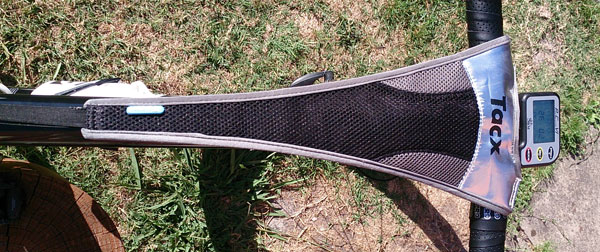
This Tacx Sweat Cover saves your stem and headset from turning into an ugly salty corroded mess. For $22/EUR20 it is well worth it. One side is elasticated and loops around your seat post. There are two velcro straps at the front which loop around the bars. This one is good as it is narrow enough to not touch your knees.
saves your stem and headset from turning into an ugly salty corroded mess. For $22/EUR20 it is well worth it. One side is elasticated and loops around your seat post. There are two velcro straps at the front which loop around the bars. This one is good as it is narrow enough to not touch your knees.
Powermeter on the turbo
You will need some way to quantify your efforts on the turbo. There are a few methods of doing this. The important thing is to be able to compare workouts, not the absolute figure.
The O'Bree speedo method
With this method you have a dedicated turbo and bike and leave them set up together. A magnetic resistance unit is recommended as this is less prone to resistance change with temperature. You fit a rear wheel speedometer and then judge the intensity of the ride based on speed and distance. For example you may decide to do a hard 20 minutes. You will know that a speed of, say 27.2mph is something you can maintain, so you can aim for that speed. The distance recorded (or average speed) will give you a measure of how you did over the duration of the interval.
This is a cheap solution and does work. It could be said that the accuracy of the speedometer is greater than that of a powermeter. However it does require a dedicated turbo set up that cannot be altered. Tire pressure must be kept constant, but resistance is affected by air temperature and tire/roller wear. If you ever moved house or had to take apart the unit, then it would be difficult to compare results from one year to the next.
Heart Rate monitor
Heart rate is quite variable depending on external variables such as temperature, fatigue and hydration. It does not correlate perfectly to power output at the pedals. It takes time to rise and fall in response to stimuli.
However it can be a useful training tool. If you are familiar with your heart rate at a certain level of wattage, then you can usually do quite a good session, e.g. 2 x 20minutes at threshold heart rate. Remember that your heart rate could take a good 5 minutes to rise up to a steady value, so don't start off too hard. As you get warmer, heart rate also tends to drift, so maintaining a heart rate will usually mean dropping power output.
If power measurement is not available, such as when on holiday, then this is a good substitute.
Turbo with power reading method
The Tacx Flow
The Kurt Kinetic
In my experience, the Tacx Flow
A power reading turbo will cost a lot less than a power meter, but you won't of course be able to see your power on the road.
If you have a power meter then I recommend the Tacx Blue Motion 35% off here and more off here.
Gym bikes with power readings
Gym bikes with wide saddles and very high handlebars, combined with a platform for an iPad and wide Q-factor are usually inaccurate in terms of power output. Only use these in times of desperation, such as when travelling.
Some spin classes are now offering bikes with power readings. Many of these appear to be inaccurate. They are calibrated at the factory and never need to be re-calibrated. Readings between bikes vary by -+50W at 300W. The power should be ignored.
Better quality bikes such as the Wattbike seem to provide more reliable readings, but it is difficult to know how accurate. In personal tests, a Wattbike was under reading by around 80W-100W. The rider in question would have been putting out about 350W at a known heart rate, but it was displaying as 250W.
Powermeter: SRM, Powertap, Quarq, Garmin Vector, Stages, Power2Max
This is the best option for empirical measurement of power output. You can download the data and send it to your coach or keep it for future reference. These power meters can be calibrated accurately. If you are training seriously, you don't want to be concerned about whether a reading really is low or if it is your legs just feeling bad. Such doubts are the stuff of nightmares for serious cyclists. I've written an article about power meters here.
Turbo Tires
Don't use your good race tires on the turbo. They will wear into a square shape very quickly and so will waste money and time. Either use old tires or purchase a special turbo tire. Of course, that means you'll need a special turbo wheel too. The alternative is to be swapping tires before every turbo session which is way too much hassle.
You might also consider a special front wheel for the turbo. I was told that hub bearings are designed for rolling and not static loads, so using your best race wheel on the front might wear out the bearings and cones. This is not something I have tested, but may be worth considering.
I've used Orange Continental tires before. After a couple of years' use I noticed some lumps forming on the tire. These grew larger, like inner tube hernias. The tire was also causing punctures and became useless. However I can say that the tread did not wear at all.
I then swapped to blue Schwalbe turbo tyre. After only a year lumps formed and so it had to go.
I then switched to a red Vittoria tyre, and so far all has been well. This was also the cheapest tire of the three.
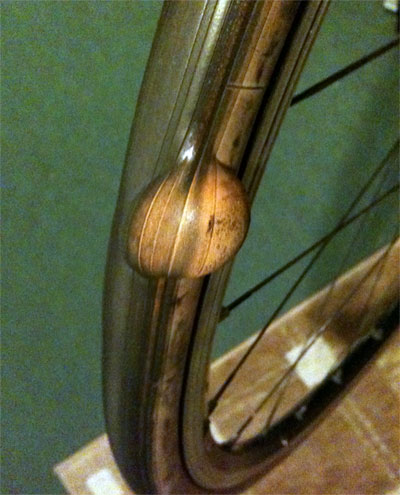
This Continental Turbo Tyre developed a hernia after about 400 hours of riding. You can see that the tread isn't worn but the tire wall has failed.
Front wheel riser
This is useful to have. I've tried using phone books (not waterproof and these days they are not thick enough) and an old biscuit tin with a dent on the top. For the sake of a few dollars, a proper wheel holder is best. The Tacx Skyliner Front Wheel Support is a good choice.
Body position
It is tempting to do all your turbo training on the brake hoods or tops of the bars, as this is generally more comfortable than the drops. However, in the important parts of a race you are probably riding on the drops. In that case, you should perform intense training in that position.
One of the early changes made in the team GB pursuit squad was to make the riders perform their road training in the same position as their pursuit bikes. Previously they had been spending hours on their road bikes, which was a different position. If you want to be able to ride fast on the drops then you need to train your body for the position.
What to drink
As most turbo sessions will be of less than two hours, I recommend only drinking water during the session. Try to avoid drinking sugary drinks every day. It'll save your money and teeth.
What training to do on the turbo
This will of course vary depending on the time of year and what your goals are. There are a few staples that seem to work well. Remember to always warm up first, as described above.
2 x 20 at FTP
This is a good session for threshold training. Establish what power you can ride at for 1 hour flat out. This is your FTP, e.g. amateur 265W, pro 400W. You can do this by either riding a 1 hour time trial or doing a 20 minute time trial then subtracting 5% off the score. I've written more about finding your FTP here.
Once you know your FTP you can then use it in your training. Ride two blocks of 20 minutes at your FTP power. You can separate the blocks by 5 or even 10 minutes. Choose a cadence of between 85-100 RPM. Lower RPMS yield a lower heart rate for the same power but might make your knees and suplesse suffer (la souplesse = fluid pedaling action).
Once you've got good at this, you could try adding on further minutes, building up to 3 x 20 minutes.
This session can be done twice a week in the off season and once a week during the season. If you are concentrating on time trialing, then this probably should constitute the majority of your training.
2 x 20 at 90%FTP
Some riders say that riding 2 x 20 twice a week is too mentally taxing. Riding at 90% of FTP should provide all of the benefits but with less of a physiological burden, so you'll be fresher for other workouts.
I have tried this and it is less exhausting to ride at 90% FTP. While there may be less of a training effect at this pace, it does mean you are more likely to do the session.
Micro bursts
Try riding for 40 minutes at 90% FTP, but with 10 second bursts every 2 minutes. Stay seated, throw it up a couple of gears and really crank it. Keep the power at 90% FTP straight after and allow your heart rate to recover. Also known as Bill Black's hour of power
This is demanding, so don't perform an effort like this more than once a week.
Over and under
Try riding at 130-150% FTP for 1 minute, then at 80-90% FTP for 4 minutes. Do this for 40 minutes. It will teach you to go into the red zone then recover while still putting out reasonable power. Like micro bursts, this is a tough session, so no more than once a week.
Endurance
Do not forget your other levels of training. Pro riders have been known to ride for 7 hours on a trainer. This will of course result in a numb bum and incredible boredom, so isn't recommended on a turbo. Do it on the road in the sunshine. 2 hours at 230W might be a good endurance ride on the turbo should you be constrained by weather.
VO2 intervals
These were tried by a teammate of mine and he had his best ever season off the back of this. They are very demanding intervals and if done more than once a week will result in getting sick.
The intervals consist of 3 sets separated by 5 minute breaks. You may find that you need more than 5 minutes' recovery between sets. That's OK, as the important thing is to give a high performance during each interval set.
Each set is as follows: 5 minutes, 3 minutes, 2 minutes, 3 minutes with 1 minute recovery between each. Each interval should start with 60 seconds of very hard effort to get your heart rate up as high, typically your heart rate at FTP. Back off the power to the hardest you can sustain for the remaining time and keep it constant. You probably won't be able to complete 3 sets at first. 2 is enough.
I repeat: you have to be fit before you do this sort of training. It'll bring you to a peak within 4 weeks, and can easily result in getting sick. No efforts like this more than once a week. But it works.
Sprints
I recommend doing sprint intervals on the road:
- You can produce more power when on the road which yields a better training effect. I find it difficult to produce over 1000W on a trainer but easily do this on the road.
- sprinting is about handling as well as pure power. You need to ensure the back wheel stays on the tarmac, be able to sprint around corners and over lumps in the road. You don't get any of that on a trainer. The fixed position of the bike is unnatural for sprinting.
- There will be less strain on your frame if you stay seated on the trainer. Carbon lugs are usually fine, but have been known to disintegrate when used with a trainer.
High cadence training
Turbo can be useful for this. There can be some significant bounce when cadence is over 150rpm, so this is better done on the road. My record is 213RPM for 10 seconds.
One legged riding
It isn't surprising that most riders have some leg strength imbalance. This could be addressed with one legged cycling. However it has also been noticed that at higher power outputs the legs produce very similar power, and discrepancies are only noticed more at lower power outputs. My view is that one legged riding isn't very useful.
Just remember to train all of your energy systems/ zones
That means not riding flat out every time you get on the turbo. This will cause you to peak early in the season and will end in sickness or getting stale. I will tend to ride specific 1 hour workouts on the turbo and will do endurance and sprint work outside when possible.
Different workouts should be planned for different phases of your training.
Don't ride the turbo every day. There is only so much you can take. You need to do the work to get fit but you need to balance this with enjoyment.
Summary
Turbo training is an excellent way to dial in a precise workout. It protects you from the hazards of weather, darkness and traffic. Learn to start each session gently and you will begin to enjoy and even look forward to your turbo sessions. Don't ride hard every time you get on the turbo - remember the big picture and how this session fits with your season.
I would love to hear your turbo tips and comments.
Links
Tacx Klimtrainer review by Road Cycling UK
Research showing that favourite music reduced the perceived exertion more than video
Lemond Revolution Trainer Link to Amazon
Minoura Action Roller Advance at Amazon
SRM Indoor Trainer
SoundBot- SB220 Bluetooth Noise-Cancellation Stereo Headphone for Music Stream & HandsFree Calling w/ 20 hrs Extended Talk and Playback Time, 400 hrs Standy time, Built-in Mic, A2DP, AVRCP at Amazon
Tacx Sweat Cover
Tacx Flow
Kurt Kinetic
